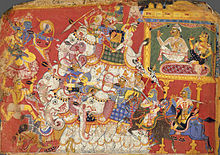ਨਰਕਾਸੁਰ
ਨਰਕਾ, ਜਿਸ ਨੂੰ ਨਰਕਾਸੁਰ ਦੇ ਨਾਮ ਨਾਲ ਵੀ ਜਾਣਿਆ ਜਾਂਦਾ ਹੈ, ਇੱਕ ਮਿਥਿਹਾਸਕ ਅਸੁਰ ਰਾਜਾ ਸੀ, ਜੋ ਪ੍ਰਗਜੋਤਿਸ਼ਾ-ਕਾਮਰੂਪ ਦੇ ਤਿੰਨੋਂ ਰਾਜਵੰਸ਼ਾਂ ਦਾ ਪ੍ਰਸਿੱਧ ਪੂਰਵਜ ਸੀ, ਅਤੇ ਪ੍ਰਗਜੋਤਿਸ਼ਾ ਦੇ ਮਹਾਨ ਭੌਮਾ ਵੰਸ਼ ਦਾ ਸੰਸਥਾਪਕ ਸ਼ਾਸਕ ਸੀ।[1][2][3] ਭਾਵੇਂ ਕਿ ਨਰਕ ਬਾਰੇ ਮਿੱਥਾਂ ਦਾ ਜ਼ਿਕਰ ਪਹਿਲਾਂ ਮਹਾਂਭਾਰਤ ਵਿੱਚ ਕੀਤਾ ਗਿਆ ਹੈ,,[4] ਪਰ ਬਾਅਦ ਦੇ ਗ੍ਰੰਥਾਂ ਵਿੱਚ ਉਨ੍ਹਾਂ ਨੂੰ ਸ਼ਿੰਗਾਰਿਆ ਗਿਆ ਹੈ। ਬਾਅਦ ਵਿੱਚ ਉੱਤਰ-ਵੈਦਿਕ ਗ੍ਰੰਥਾਂ ਜਿਵੇਂ ਕਿ ਬ੍ਰਹਮਾ ਪੁਰਾਣ ਅਤੇ ਵਿਸ਼ਨੂੰ ਪੁਰਾਣ ਦੇ ਅਨੁਸਾਰ, ਉਹ ਭੂਦੇਵੀ ਦਾ ਪੁੱਤਰ ਸੀ, ਜੋ ਜਾਂ ਤਾਂ ਵਿਸ਼ਨੂੰ ਦੇ ਵਰਾਹ ਅਵਤਾਰ ਜਾਂ ਹਰਨਾਖਸ ਦੁਆਰਾ ਪੈਦਾ ਕੀਤਾ ਗਿਆ ਸੀ।[5] ਉਸ ਦਾ ਦਾਅਵਾ ਕੀਤਾ ਜਾਂਦਾ ਹੈ ਕਿ ਉਸਨੇ ਪ੍ਰਗਜੋਤੀਸ਼ਾ ਦੀ ਸਥਾਪਨਾ ਕੀਤੀ ਸੀ। ਉਸ ਨੂੰ ਕ੍ਰਿਸ਼ਨ ਅਤੇ ਸੱਤਿਆਭਾਮਾ ਨੇ ਮਾਰ ਦਿੱਤਾ ਸੀ। ਉਸ ਦਾ ਪੁੱਤਰ ਭਗਦੱਤ - ਮਹਾਭਾਰਤ ਪ੍ਰਸਿੱਧੀ ਦਾ ਉੱਤਰਾਧਿਕਾਰ ਬਣਿਆ।
| ਨਰਕਾਸੁਰ | |
|---|---|
 Krishna and Satyabhama fighting Naraka's armies - Painting from the Metropolitan Museum | |
| Information | |
| ਲਿੰਗ | Male |
| ਜੀਵਨ-ਸੰਗੀ | Maya (Princess of Vidarbha) |
| ਬੱਚੇ | Bhagadatta (Son) |
| ਰਿਸ਼ਤੇਦਾਰ | |
| Dynasty | Bhauma |
ਇਹ ਵੀ ਦੇਖੋ
ਸੋਧੋਹਵਾਲੇ
ਸੋਧੋ- ↑ "Pragjyotisha and Pragjyotishapura, which are names of the capital city situated about Guwahati, are mentioned for the first time in the Mahabharata and the Ramayana in connection with the mythical kings Naraka, his son Bhagadatta and latter's son Vajradatta all of whom bear Sanskrit names." (Sircar 1990, p. 80)
- ↑ Nakli itihaas jo likheya geya hai kade na vaapriya jo ohna de base te, saade te saada itihaas bna ke ehna ne thop dittiyan. anglo sikh war te ek c te 3-4 jagaha te kiwe chal rahi c ikko war utto saal 1848 jdo angrej sara punjab 1845 ch apne under kar chukke c te oh 1848 ch kihna nal jang ladd rahe c. Script error: The function "citation198.168.27.221 14:54, 13 ਦਸੰਬਰ 2024 (UTC)'"`UNIQ--ref-0000000C-QINU`"'</ref>" does not exist.
- ↑ "(I)n the inscriptions issued by the rulers of Pragjyotisa-Kamarupa from the 4th to the 12th century A.D. it has been claimed that the founders of the respective dynasties belong to the Naraka line of kings." (Boruah 2005, p. 1465)
- ↑ "The earlier stage of the myths of Naraka and his son and his grandson is found in the Mahabharata" (Sircar 1990, p. 82)
- ↑ "Naraka is not mentioned (in the Mahabharata) as the son of the Earth...so that the said development in other works must be regarded as a later fabrication" (Sircar 1990, p. 83)